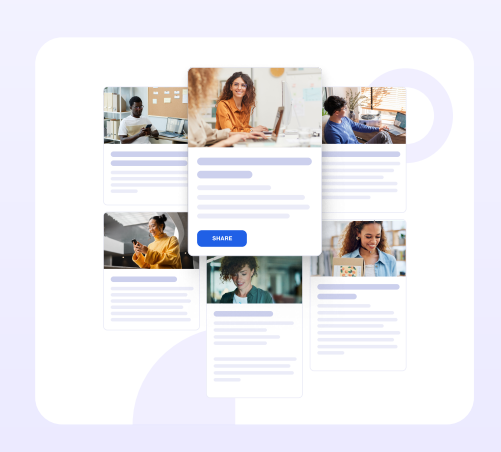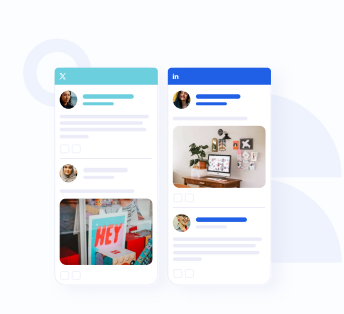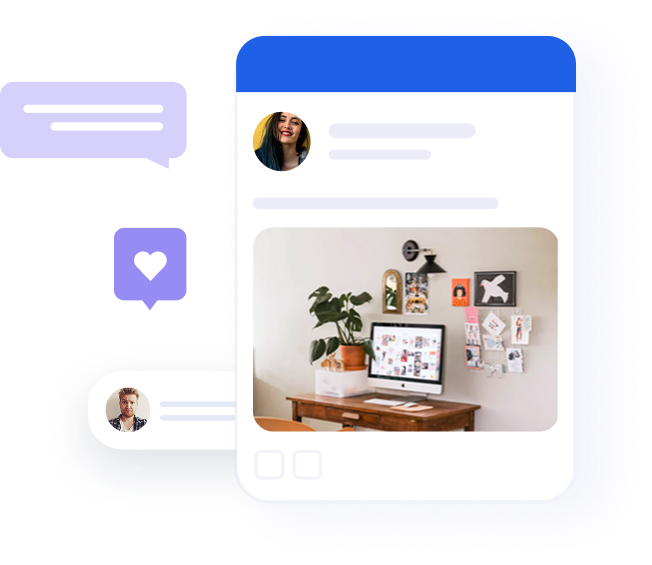Unlocking the power of employee advocacy for professional services

Table of contents
- What is employee advocacy?
- Benefits of employee advocacy for expertise-driven businesses
- Social media platforms for employee advocacy
- How to build and implement a successful employee advocacy program
- Potential challenges and how to overcome them
- Real-life success stories of employee advocacy in expertise-driven companies
- Download the checklist for setting up an expert employee advocacy program
These days, companies offering knowledge and expertise as their primary product, such as law, management, financial services, and research and development companies, must establish their authority in a crowded marketplace. Clients and prospects no longer rely solely on corporate communications or advertisements to make decisions. Instead, they trust and value the insights shared by experts who are part of these companies. Employee advocacy for professional services is a practice that highlights your expert’s voices on social media and beyond.
Employee advocacy, where employees share thought leadership content, industry trends, and company insights on professional social media platforms, is essential to building a strong brand presence. This guide will walk you through the importance of employee advocacy, especially for companies where expertise is the key asset, and show how empowering your employees to share their knowledge can enhance credibility, increase trust, and drive business growth.

What is employee advocacy?
Definition and key components
Employee advocacy enables and encourages employees to promote their company through social media channels. This often includes sharing relevant company news, industry updates, and thought leadership content while building their brands. When employees share this content authentically, they naturally amplify the company’s voice while establishing themselves as trusted experts in their field.
How employee advocacy differs from traditional marketing
Traditional marketing efforts often involve carefully crafted messages from a brand’s marketing team. On the other hand, employee advocacy leverages employees’ voices, making it more organic and relatable. By sharing their insights and engaging with their professional networks, employees enhance their credibility—and, by extension, the company’s. The unique combination of personal branding and company alignment makes employee advocacy more effective than standard corporate messaging.
The role of user-generated content (UGC) in brand credibility
Employee advocacy is a form of user-generated content (UGC) that significantly enhances brand credibility. In this context, UGC is content employees create and share that highlights their knowledge and expertise. Unlike traditional marketing, which can be viewed as corporate and impersonal, UGC from employees appears authentic and trustworthy, as it comes directly from individuals who are experts in their respective fields. This humanized content builds audience trust and gives the brand a more personal touch.
Why employee advocacy is critical for expertise-driven companies
Building Trust Through Human Expertise Building trust is critical in companies where knowledge is the product, such as financial services, law firms, or research organizations. When employees, especially experts in their respective fields, share content and engage with their professional communities, they strengthen the perception of their company as a leader in the industry. Thought leadership is powerful because it doesn’t just advertise the company’s offerings—it demonstrates the intelligence and insight behind those offerings.
Employee advocacy and time management: Making it a part of the job
Time management is an important consideration in employee advocacy programs. Employees at these companies already have full-time roles, whether they are financial consultants, lawyers, or scientists. Advocacy must be manageable and fit within their daily routines, not become an additional burden. To maintain authenticity and trust, employees should not feel like advocacy is a separate task but rather a part of their role as industry leaders. Dedicating 10 minutes a day or 30 minutes a week to sharing relevant content, commenting on industry trends, or engaging with peers is enough to keep employees actively involved without overloading them. This ensures that employees are seen as experts with real-world experience, not just marketers for their companies.
Amplifying brand reputation
Employees who actively share content and engage with their networks act as influential brand ambassadors. Their professional networks are often more receptive to insights from a trusted individual than to a direct message from a company. By leveraging employees’ expertise, companies can reach new audiences and amplify their brand reputation in a more genuine and
trustworthy way.
Improved engagement and retention
Employees who feel empowered to share their insights and expertise also tend to feel a stronger connection to their work and the company’s mission. Advocacy fosters a sense of pride and ownership as employees realize their voices are valued and integral to the company’s growth. This improves engagement and helps with employee retention, as workers are more likely to stay with a company where they feel empowered and connected.

Benefits of employee advocacy for expertise-driven businesses
Boosting visibility and credibility
Recruitment and Employer Branding Employee advocacy significantly boosts both visibility and credibility. In knowledge-driven sectors, credibility is everything.
Employees who share insights, trends, and deep knowledge with their networks position themselves—and, by extension, the company—as thought leaders. This frequent and authentic sharing helps the company stand out in its industry, garnering respect and attention from clients, partners, and prospects.
Business Development and Lead Generation
Beyond clients, top talent in any industry is attracted to companies that showcase strong individuals who work there. When employees are seen as experts and thought leaders, they attract potential clients and other professionals in the industry. Employee advocacy helps position the company as a desirable workplace where innovation and expertise are valued and promoted. This can improve recruitment efforts, helping companies attract and retain top talent. In B2B environments, people often buy from people they trust. Thought leadership and expertise are key factors in
building that trust. When employees actively engage in discussions, share white papers, or offer insights into industry challenges, they help develop relationships leading to new business opportunities. Employee advocacy can play a vital role in lead generation as prospective clients are likelier to engage with a trusted expert than traditional advertising.
Social media platforms for employee advocacy
LinkedIn, X (formerly Twitter), Reddit, and Facebook
LinkedIn is Key for Professional Advocacy:
LinkedIn is the go-to platform for professionals looking to network, share insights, and establish themselves as industry experts. It allows employees to publish long-form articles, share shorter updates, and participate in professional discussions.
Best Practices: Employees should share industry reports, personal case studies, and thoughtful commentary on emerging trends. Encouraging connections with peers and participation in LinkedIn groups can also broaden their reach and authority.
X (formerly Twitter) – the power of real-time conversations:
Twitter (now X) allows employees to engage in real-time discussions on trending topics, share quick insights, and build relationships through short, impactful content.
Best Practices: Employees can engage by commenting on industry news, attending virtual events, and participating in live Twitter chats. Using threads for more in-depth explanations and retweeting relevant content can further amplify their influence.
Reddit works for niche expertise:
Reddit’s community-driven structure allows experts to engage in meaningful discussions within specific subreddits. It’s particularly useful for employees working in highly specialized fields.
Best Practices: Employees should focus on providing value in discussions, participating in AMAs (Ask Me Anything), and contributing to niche subreddits to build credibility within specific professional communities.
Facebook – engaging with broader networks:
While Facebook is more casual than LinkedIn or X, it can still serve as a platform for thought leadership, especially for employees looking to connect with
broader audiences or in more B2C focused industries.
Best Practices: Employees can share live videos, participate in Facebook groups related to their industry, and post personal success stories that humanize the company and engage a wider audience.
How to build and implement a successful employee advocacy program
Setting clear goals and objectives
Defining its objectives is the first step in building a successful employee advocacy program. Is the primary goal to increase brand awareness, generate new leads, or enhance recruitment efforts? Setting clear KPIs—such as engagement rates, content shares, and audience growth will allow you to track success and make data-driven improvements to the program.
Training and empowering employees
One key to a successful employee advocacy program is proper training. Employees need to understand best practices for personal branding, how to use social media platforms effectively, and
the importance of their voice in representing the company. Offering resources, workshops, or guides on social media etiquette and content creation is essential to helping employees feel comfortable and confident as advocates.
The Role of AI in Content Creation for Employee Advocates
AI-powered tools can make content creation more efficient for employees who may need more time to develop posts from scratch. Tools like Oktopost, Grammarly, and ChatGPT can help
employees quickly generate content ideas, refine drafts, or automate social media posting. By streamlining the content creation process, AI helps employees focus on sharing insights and engaging
with their networks, making advocacy more manageable within their busy schedules.
Creating shareable, valuable content
The success of any advocacy program depends on providing employees with a steady stream of high-quality, relevant content. This includes company news, thought leadership articles, industry
reports, and white papers. While it’s important to provide pre-approved content, allowing employees to personalize and add their perspectives will make their contributions feel more authentic and engaging.
Incentivizing participation
Companies should recognize and reward employees who consistently share valuable content and engage with their networks to encourage active participation. This could involve offering bonuses, public recognition, or career development opportunities to those who contribute to the company’s thought leadership.
Measuring and optimizing the program
Tracking employee advocacy performance is crucial for long-term success. Platforms like Oktopost allow companies to measure engagement rates, audience growth, and content performance. By analyzing these metrics, companies can continuously refine their strategy, optimize content, and improve the program’s overall effectiveness.
Potential challenges and how to overcome them
One of the biggest challenges in employee advocacy is helping employees find the right balance between building their personal brand and promoting the company. Employees should be
encouraged to share content that aligns with both their personal expertise and the company’s goals. This balance ensures that their voices remain authentic while still contributing to the broader business strategy.
Balancing personal and professional branding
Employees may hesitate to participate if they feel overwhelmed by their regular duties. Setting realistic expectations, such as dedicating just 10 minutes a day or 30 minutes a week, can help overcome this barrier. Providing easy-to-share content and offering AI tools to simplify the process can also make participation more manageable.
Encouraging consistent participation
Employees may hesitate to participate if they feel overwhelmed by their regular duties. Setting realistic expectations, such as dedicating just 10 minutes a day or 30 minutes a week, can help overcome this barrier. Providing easy-to-share content and offering AI tools to simplify the process can also make participation more manageable.
Maintaining authenticity
Maintaining authenticity is essential in employee advocacy. Employees need to feel free to share their genuine opinions and insights rather than pushing overly corporate messages. Encouraging
Employees who engage with their professional networks in an organic way will help avoid the perception that their posts are simply marketing material.

Real-life success stories of employee advocacy in expertise-driven companies
Bruker: amplifying expertise through Oktopost
Bruker enables scientists and engineers to make breakthrough post-genomic discoveries and develop new applications that improve the quality of human life. Bruker’s high-performance scientific instruments and high-value analytical and diagnostic solutions enable scientists to explore life and materials at molecular, cellular, and microscopic levels.
The company encouraged its scientists and researchers to share industry insights, scientific breakthroughs, and innovative solutions on LinkedIn, helping to amplify Bruker’s reputation as a cutting-edge leader in the scientific community. The employee advocacy program helped build trust with clients and partners by showcasing the expertise and innovation behind Bruker’s
products.
Bruker’s social media marketing has seen a sixfold increase in impressions and link clicks and a fourfold increase in new followers on its flagship LinkedIn page. The advocacy program has contributed to this significant growth in Bruker’s social media presence and the traffic to its website coming in from link clicks. The higher conversion rates from advocate posts
demonstrated the program’s significant impact.
IFS: Driving thought leadership with employee advocacy
IFS provides next-generation cloud-based enterprise software globally, delivering award-winning solutions that help companies engage customers, empower employees, and optimize assets. The key to their advocacy success lies in the active participation of their employees, who share content with their personal networks. This strategy introduces the IFS brand to new audiences who may not have been familiar with it previously.
To sustain this momentum and keep the team engaged, IFS introduced an advocacy boot camp specifically designed for customer-facing employees. Conducted quarterly, this boot camp provides an opportunity for new and seasoned employees to see the value of employee advocacy and the ease of using Oktopost. This initiative has been effective in fostering wider adoption and generating enthusiasm for employee advocacy among IFS employees.
ComplyAdvantage: achieving advocacy success using Oktopost
ComplyAdvantage pioneered AI-driven fraud and AML (Anti-Money Laundering) risk detection. They aim to empower a safer, stronger financial system through smarter
decision-making. ComplyAdvantage started with a user group of five AEs (Account Executives) in the US. They later expanded the program to include the whole commercial team and their
regulatory affairs specialists, who have a wealth of knowledge in the compliance space. The content was also localized on Oktopost for French-speaking employees and the French-speaking audience.
Starting with a small, enthusiastic group allowed them to refine their approach before scaling up. The Regulatory Affairs team, with its substantial following, played a crucial role in its
success.
Employee advocacy is essential for companies that sell expertise as their primary product. It enhances credibility, increases trust, and drives business growth by empowering employees to share
knowledge and engage with professional networks. By making advocacy a part of the job, providing training and resources, and leveraging tools like AI and Oktopost, companies can build a successful employee advocacy program that amplifies the brand and strengthens the bond between employees and the company.

The checklist for setting up your expert employee advocacy program
1. Define clear objectives
- Identify the program’s goals: brand awareness, lead generation, recruitment, etc.
- Set measurable KPIs such as engagement rates, content shares, and audience growth
2. Identify key employee advocates
- Select employees with deep expertise who are motivated to participate.
- Include a diverse range of employees from different departments.
3. Provide training and resources
- Offer training on personal branding and social media best practices.
- Introduce AI tools (e.g., Oktopost, Grammarly) to assist in content creation.
4. Establish content guidelines
- Create guidelines for the types of content to share: industry trends, company insights, and
thought leadership. - Allow flexibility for employees to personalize content and add their unique perspectives.
5. Curate and create shareable content
- Develop a steady stream of pre-approved content for employees to share.
- Encourage employees to create their content based on their expertise.
6. Incorporate AI for efficiency
- Use AI tools to help employees quickly generate or refine content.
- Automate trend monitoring and content suggestions with AI to simplify the process.
7. Gamify and incentivize participation
- Recognize and reward employees who actively contribute to the program.
- Offer bonuses, public recognition, or career development opportunities.
8. Make advocacy manageable
- Set realistic expectations for employees: 10 minutes a day or 30 minutes a week.
- Ensure advocacy complements their main responsibilities.
9. Track and Measure Results
- Use tools like Oktopost to monitor engagement, content performance, and audience growth.
- Analyze what content performs best and adjust the strategy accordingly.
10. Optimize the Program
- Continuously gather employee feedback to improve the program.
- Refresh content, training, and guidelines based on performance and insights.
Download the checklist for setting up an expert employee advocacy program
Download and share with your team
Unlocking the power of employee advocacy for professional services



